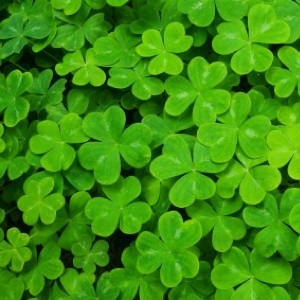
One plant that gets a lot of attention this time of year is the Shamrock. Although its mysterious history dates back to ancient Ireland, a bit of botanical controversy still exists about which plant is actually the Irish national symbol. Here's a closer look at this popular March plant.
The word shamrock comes from the Gaelic word "seamrog," meaning "little clover," however botanically speaking, there is really no such thing as a Shamrock plant. It is the trifoliate-shaped leaves of the clover plant that forms the symbol we have come to know as the shamrock.
In an effort to nail down a specific plant, an interesting survey was conducted in 1988 by botanist Charles Nelson of the National Botanical Gardens Glasnevin, in Dublin, Ireland. The survey asked Irish citizens to take pictures and send in samples of the plant they consider most representative of their national symbol. No fewer than five plants made the list:
Today, most experts in all things Irish accept ordinary White Clover (Trifolium repens) as the clover that produces "Shamrocks," although many florists still sell varieties of Oxalis (and their shamrock-shaped leaves) as traditional Shamrock plants during the month of March.
Clovers occasionally mutate to have four leaflets, instead of the usual three. These four-leaf clovers, like other rarities in nature, are considered lucky. The mutants are technically called "four-leaf clovers" however, and are not the same as Shamrocks.
White Clover (Trifolium repens)
White Clover is a long-lived perennial that grows 3-leaf clovers and blooms year after year. It grows and flowers best in full sun, with one teaspoon of seeds covering an area of approximately 4 square feet.
The Benefits:
The Drawbacks:
Despite it's benefits, white clover can quickly become well-established and takes over your lawn if left unmanaged. In many parts of the country, it is considered an annoying weed and is listed by the U.S. Department of Agriculture as an invasive species.
Oxalis deppei 'Iron Cross'
Also associated with shamrocks, this perennial plant is a variety of oxalis. It often appears in stores around early March and is sold as the "Good Luck Shamrock" plant. The green, trifoliate leaves have an iron-colored variation in the middle in the shape of a cross-hence its name. Oxalis deppi grows in 12 inch tall clumps and produces dark pink flowers from mid summer through mid fall.

About The Author: Ellen Brown is an environmental writer and photographer and the owner of Sustainable Media, an environmental media company that specializes in helping businesses and organizations promote eco-friendly products and services. Contact her on the web at http://www.sustainable-media.com
Add your voice! Click below to comment. ThriftyFun is powered by your wisdom!